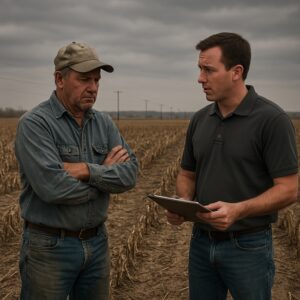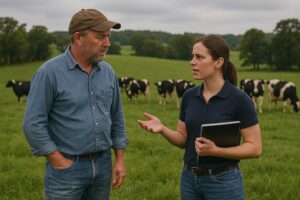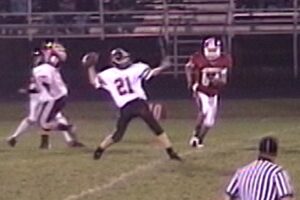[fusion_builder_container hundred_percent=”yes” overflow=”visible”][fusion_builder_row][fusion_builder_column type=”1_1″ background_position=”left top” background_color=”” border_size=”” border_color=”” border_style=”solid” spacing=”yes” background_image=”” background_repeat=”no-repeat” padding=”” margin_top=”0px” margin_bottom=”0px” class=”” id=”” animation_type=”” animation_speed=”0.3″ animation_direction=”left” hide_on_mobile=”no” center_content=”no” min_height=”none”][fusion_text]
- Make it routine – Weekly phone calls are best to accelerate change. Same coaching day, same coaching hour – week over week and don’t cancel them. Show your sales professional how important their development is by keeping the time scheduled. Much of Ag sales activities are seasonal. Obviously avoid the busiest season if the situation dictates.
- Keep a running log of what you covered in previous sessions, what you agreed on and what action items you both agreed the sales person would complete by the next phone call. There’s nothing worse than not preparing for the coaching session. Again, show your sincerity to the coaching program by preparing for it.
- It’s a marathon – not a sprint (unless there are major behavior/performance issues). Steady progress is better than no progress and is more sustainable over time. Baby Steps – Take it slow and steady in the beginning. Your sales person may have to change core behaviors or personal styles that are deeply embedded in the way they operate. Give them some space to make those changes gradually if they are major ones.
- Ride Alongs- This is where coaching the Ag Sales Professional gets exciting. Not all (maybe none) of your team will thoroughly enjoy the ride along. It’s stressful having your supervisor in the car all day and watching your sales calls. However, it is the best way to determine what is going on during their sales calls. You can train and prepare all you want, but seeing their sales skills in action is the clearest method to determine how they are doing. Realize that it’s never exactly the same as when the sales person is one on one with their customer. A third person changes the dynamics of the farm call depending on how it’s handled. As the coach, try as hard as possible to stay in a coach role and not in a supervisor role. Focus on the sales process and not on other managerial activities with the sales person. If need be, deal with those at the end or start of the day.
- As the coach – never take over the call unless total disaster occurs. Even then, only in rare cases. This is difficult because many of us were in sales ourselves and we see obvious opportunities that this sales person is missing. Maybe cue a few prompts but otherwise don’t jump in to “bail them out”. You will most likely do more damage to the sales person’s ego and/or the customer’s image of your sales person and you.
- Introduce yourself and explain your role in the company. The farmer wants to know who you are and how you fit into the company. Get it out of the way early, so they don’t have to guess. It helps build trust faster.
- After introductions, quickly get the focus back on the sales person or the farming operation. Then let the sales person jump back in.
- I am reluctant to hand out my business card on ride alongs. I want to keep the company contact with the sales person. I never want to give the wrong impression that the customer can now get answers from me. For one, as a sales manager, you don’t have the time. Secondly and more importantly, you want to keep the authority/power/respect with the sales person.
-
- Plan the ride along in advance with your sales person.
- Don’t go to the same customers every ride along
- Don’t go to the really easy customers that don’t give you a view of the sales persons’ skills
- Don’t just go to the customer that’s angry and wants to chew on “management”. Certainly go if needed to keep or calm a customer down. But don’t make that a part of the coaching ride along every time.
- Do go to see a customer/prospect that will give you a view of the behavior you are coaching on. If you want to see how they are doing at digging in and asking a lot of high value questions, then make sure you are going to a newer customer or one that you aren’t getting all of their business. Don’t go to the Steady Eddy-Best Friend customer. The sales person probably knows everything about them.
- Do go to customers that are part of the top 20% of your sales person’s list. If you go to the producer with 15 cows, even if you get all the business, you haven’t been to a representative customer from the sales person’s customer list. This happened once – Worst part is we didn’t even get the business. Worst-worst part is we didn’t ask how big his herd was until late in the call.
- Do plan to take 30 minutes in advance of the call to review the pre-call plan with your sales person. This is important. It tells you how well the sales person is preparing for their farm calls. See future blogs on good formats for a pre-call plan.
- Do plan to take at least 30 minutes after the farm call to evaluate how the call went. As important as the pre-call 30 minutes were, this one is even more important. While fresh in the everyone’s mind, stop for a few minutes and review how the call went. You will be amazed at the difference of opinions sometimes you get on how the call went.
- Plan the ride along in advance with your sales person.
- Peer Ride Alongs – This is a great development tool. A couple of key points:
- Help facilitate the ride along. Many sales people are a little shy about calling another sales person out of the blue and asking to ride along with them.
- Match your sales person with the right sales person to ride along with. It’s tempting to have them ride with the highest performing or the closest geographically to them. Both might be ok, but look for sales people that possess the behaviors you are working on with your sales person. It might not be the person at the top of the sales charts.
- Have them ride with at least two other sales people (3-4 over the course of a year is better). This gives your sales person a better reference and increases the amount of professional sharing and connecting that will go on with your team.
- See future blogs on Strategic Coaching, as well as stories of my best/worst experiences in coaching Ag Sales Teams.
- Sign up to receive regular updates from AG Sales Professionals at http://gregmartinelli.net/blog/
Good luck and let me know how it goes
Greg[/fusion_text][/fusion_builder_column][/fusion_builder_row][/fusion_builder_container]



